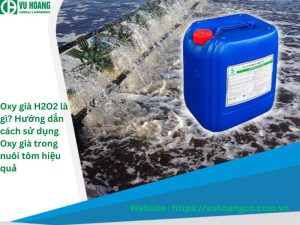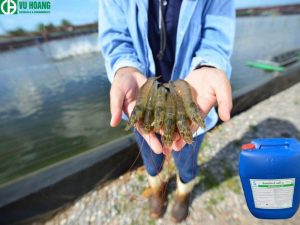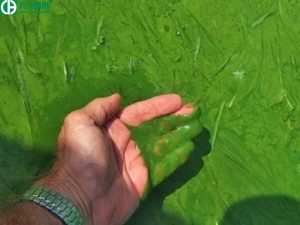Nội dung bài viết
What is hydrogen peroxide H2O2? Instructions on how to use hydrogen peroxide effectively in shrimp farming. Using hydrogen peroxide in shrimp farming is a solution that many experts in the seafood industry are interested in. Hydrogen peroxide, or hydrogen peroxide (H₂O₂) helps increase dissolved oxygen content, killing harmful bacteria, fungi and algae. Thereby reducing the risk of disease outbreaks. Used in the right dosage and method, hydrogen peroxide does more than just clean water. It also reduces toxins such as H₂S and NH₃ to help shrimp grow stronger.
In the article below, Vu Hoang Chemical will introduce in more detail the uses or notes when using hydrogen peroxide in shrimp farming. Readers, please follow the article “What is hydrogen peroxide? Instructions on how to use hydrogen peroxide in shrimp farming effectively”!
 What is hydrogen peroxide H2O2? Instructions on how to use hydrogen peroxide effectively in shrimp farming
What is hydrogen peroxide H2O2? Instructions on how to use hydrogen peroxide effectively in shrimp farming
What is hydrogen peroxide H2O2?
Hydrogen peroxide, also known as hydrogen peroxide (H2O2), is a popular antiseptic solution used in medicine and home. It is a clear liquid, slightly more viscous than water and has strong oxidizing properties. In nature, hydrogen peroxide exists in trace form in rainwater. And snow thanks to the photochemical reactions of water and oxygen in the atmosphere.
Hydrogen peroxide has been widely used in many different fields. From healthcare, industry, to agriculture, including the shrimp farming industry.
Outstanding properties of hydrogen peroxide H2O2
Hydrogen peroxide has strong oxidizing ability. Thanks to that, hydrogen peroxide (H₂O₂) has many of the following useful properties:
-
Antiseptic ability:
Hydrogen peroxide is effective in killing bacteria, fungi and viruses. When exposed to microorganisms, hydrogen peroxide will decompose into water and atomic oxygen. Releases powerful oxidative energy, attacks and destroys the cell structure of microorganisms, leading to their destruction.
Hydrogen peroxide can remove dirt, pus, dead cells and excess blood from skin and surfaces. When exposed to organic substances, hydrogen peroxide will oxidize them into simpler compounds. Easily soluble in water and washed away.
-
Mild hemostatic ability:
Hydrogen peroxide can help control mild bleeding due to its ability to create blood clots. When exposed to blood, hydrogen peroxide will decompose red blood cells. Releases hemoglobin, which plays a role in forming blood clots, helping to prevent bleeding.
-
Bleaching ability:
Hydrogen peroxide can bleach materials such as fabric, hair and skin due to its ability to oxidize pigments. When exposed to pigments. Hydrogen peroxide will break down their molecular structure, causing them to lose color.
In addition, hydrogen peroxide also has the ability to self-decompose in water and release oxygen molecules. Therefore, it will increase the amount of oxygen in the water, bringing many uses in shrimp farming in particular and aquaculture in general.
See more: >>> Use H2O2 chemicals to ensure safety in life
What is the effect of hydrogen peroxide H2O2 in shrimp farming?
Hydrogen peroxide (H2O2) has many applications in life, including shrimp farming. Thanks to its strong oxidation ability, hydrogen peroxide is used to sterilize pond water, disinfect, prevent and treat diseases caused by bacteria, fungi, and parasites to shrimp. Below are details about the effects of hydrogen peroxide in shrimp farming:
Hydrogen peroxide has the ability to self-decompose in water, releasing atomic oxygen. Helps increase the amount of dissolved oxygen in the pond. Adequate oxygen supply helps shrimp breathe better. Enhances resistance, supports healthy growth of shrimp and limits mortality. Especially effective in cases where ponds lack oxygen due to high density, sudden weather changes or when shrimp are sick.
-
Pond water treatment:
Hydrogen peroxide has a strong antiseptic effect, killing bacteria, fungi, and parasites that are harmful to shrimp. Helps disinfect pond water, improve water quality and limit the growth of pathogens. Removes excess organic matter in water, minimizing environmental pollution of shrimp ponds.
-
Prevention and treatment of shrimp diseases:
Hydrogen peroxide is used to prevent and treat diseases caused by bacteria, fungi, and parasites in shrimp. Such as: white spot disease, hepatopancreatic disease, scabies disease, fungal disease, etc. Helps shrimp increase resistance, limit the penetration of pathogens. Supports effective treatment of diseases caused by bacteria, fungi, and parasites. Helps shrimp quickly recover health.
-
Stimulating shrimp molting:
Hydrogen peroxide can stimulate shrimp to molt faster and more evenly. Therefore, it helps shrimp molt more easily and limits the rate of shrimp dying due to difficult molting. Enhances shrimp health after molting, helping shrimp grow better.
With many uses of hydrogen peroxide in shrimp farming as above. Next, shrimp farmers need to understand how to use this chemical compound to ensure the safety of their shrimp ponds.
How to use hydrogen peroxide H2O2 in shrimp farming safely and effectively
Hydrogen peroxide (H2O2) plays an important role in shrimp farming, bringing many practical benefits to farmers. However, to achieve optimal effectiveness and ensure safety. The use of hydrogen peroxide requires compliance with the appropriate dosage, time and method.
Appropriate time to use hydrogen peroxide in shrimp farming
Want to achieve efficiency and safety when using hydrogen peroxide in white shrimp farming. The first thing is to understand when it is most appropriate to use it. Below are a few appropriate timelines for using hydrogen peroxide. To use oxygen in pond water treatment, as well as to protect and prevent diseases for shrimp:
-
Before stocking:
Use hydrogen peroxide at a dose of 150ppm to disinfect pond water. Kills bacteria, fungi, and parasites that are harmful to shrimp, helping to create a safe living environment for baby shrimp.
Juvenile shrimp have a higher need for oxygen than adult shrimp. Therefore, hydrogen peroxide should be used periodically every 2-3 days at a dosage of 1mg/liter. To provide oxygen for baby shrimp to develop best.
Use hydrogen peroxide to disinfect pond water, kill remaining bacteria, fungi, and parasites after harvesting. Helps keep the pond clean and ready for the next farming season.
-
After using chemicals:
Use chemicals to eliminate bacteria, parasites or treat pond water. May reduce the amount of dissolved oxygen in water. Hydrogen peroxide should be used at a dosage of 1 – 2mg/liter after using chemicals. To provide oxygen for shrimp and help shrimp recover quickly.
Due to high stocking density, hot weather, or polluted pond water environment. The amount of dissolved oxygen in water drops below 4mg/liter, shrimp will suffer from lack of oxygen and can lead to death. Use hydrogen peroxide to provide oxygen to shrimp, helping shrimp breathe better and grow healthily.
-
When the pond water environment is polluted:
Due to excess food, shrimp waste, dead algae, etc. accumulating in the pond and pond water environment. May be contaminated, affecting shrimp health. Use hydrogen peroxide in dosage to treat pond water. Helps improve water quality and create a good living environment for shrimp.
-
When shrimp shows signs of disease:
Hydrogen peroxide can be used to prevent and treat some common diseases in shrimp. Such as: white spot disease, hepatopancreatic disease, scabies, fungal disease, etc. Use hydrogen peroxide at a dosage of 20 – 50ppm, depending on the severity of the disease. To destroy disease-causing bacteria and fungi and help shrimp recover quickly.
-
Periodic disease prevention for shrimp:
Use hydrogen peroxide at a dose of 10 – 20ppm periodically every 7 – 10 days to prevent diseases. Caused by bacteria and fungi in shrimp.
-
1-2 days before shrimp molt:
Use hydrogen peroxide at a dose of 5 – 10ppm to stimulate shrimp to molt faster. At the same time, it helps shrimp molt more easily, limiting mortality due to molting.
 Determine the appropriate time to use hydrogen peroxide in shrimp ponds
Determine the appropriate time to use hydrogen peroxide in shrimp ponds
See more articles: >>> Things to know about H2O2 – Hydrogen Peroxide
Dosage for using hydrogen peroxide H2O2
The dosage of hydrogen peroxide used in shrimp farming depends on the purpose of use and the specific condition of the pond. Below are some hydrogen peroxide dosages used in each case for reference:
- To provide oxygen for shrimp, dilute 1 – 2mg/liter of hydrogen peroxide into the water and sprinkle evenly across the pond surface. Always start with a lower dose and gradually increase if necessary. Depending on the specific conditions of the pond.
- In case of shrimp pond water treatment, when algae is detected at a dose of 150ppm. Use when detecting toxic algae. Avoid using too often so as not to affect the beneficial algae.
- For shrimp disease prevention and treatment, use 20 – 50ppm, depending on the level of shrimp disease.
- The dosage used to stimulate shrimp molting is about 5 – 10ppm. Use 1-2 days before shrimp molt to increase shrimp health.
- Using hydrogen peroxide increases shrimp resistance at a dose of about 1 – 2mg/liter. Use periodically every 7 – 10 days.
Detailed instructions for using hydrogen peroxide H2O2 in shrimp farming
In aquaculture, hydrogen peroxide is widely used for many different purposes. However, to achieve the highest efficiency and ensure the safety of the shrimp pond environment, it is necessary to use hydrogen peroxide properly. Below are detailed instructions on how to use hydrogen peroxide in shrimp farming:
Prepare:
- Hydrogen peroxide has a clear origin, ensuring quality. You should choose hydrogen peroxide with a concentration of 35% or 50%.
- Clean water to dissolve hydrogen peroxide.
- Gloves, masks, and other protective equipment to ensure safety when using hydrogen peroxide.
How to dissolve hydrogen peroxide:
Dilute hydrogen peroxide with clean water in a ratio suitable for intended use:
- Dilute 1 liter of 50% hydrogen peroxide with 1,000 liters of water to provide oxygen to shrimp.
- Dilute 2 liters of 50% hydrogen peroxide with 1,000 liters of water when treating shrimp pond water.
- Dilute 0.4 – 1 liter of 50% hydrogen peroxide with 1,000 liters of water to prevent and treat shrimp diseases.
- Dilute 0.1 – 0.2 liters of 50% hydrogen peroxide with 1,000 liters of water to stimulate shrimp molting 1 – 2 days before.
- Dilute 0.2 liters of 50% hydrogen peroxide with 1,000 liters of water for the purpose of increasing shrimp resistance: .
Next, stir the solution until the hydrogen peroxide in the water is completely dissolved.
Usage:
- Sprinkle hydrogen peroxide solution evenly across the surface of the shrimp pond or use a watering system.
- You should use hydrogen peroxide in the morning or late afternoon, avoid using it in hot weather.
- Combine the use of hydrogen peroxide with other prevention and treatment measures to achieve the highest effectiveness.
Besides understanding the time, flow as well as how to properly use hydrogen peroxide for pond water treatment. To protect shrimp health, during the implementation process, everyone needs to know the necessary notes. To avoid unnecessary consequences.
Important notes when using hydrogen peroxide H2O2 in shrimp farming
Hydrogen peroxide is also a strong chemical. If used incorrectly, it can have negative effects on shrimp and the pond environment. Therefore, farmers need to note the following points when using hydrogen peroxide in shrimp farming:
- You should choose hydrogen peroxide with clear origin and quality assurance. Choose hydrogen peroxide with a concentration suitable for intended use, 35% or 50%
- You should use hydrogen peroxide in the early morning or late afternoon when the water temperature is low. Avoid using during hot days because the effectiveness of hydrogen peroxide will decrease due to the effects of sunlight.
- Do not use pure hydrogen peroxide because it can be harmful to shrimp. Therefore, it is necessary to dilute hydrogen peroxide with water in the appropriate ratio before using it in shrimp ponds. The hydrogen peroxide dilution ratio can vary depending on the purpose of use and pond conditions.
- It is necessary to monitor the condition of shrimp ponds and adjust the hydrogen peroxide dosage accordingly. Do not use too much hydrogen peroxide because it can cause poisoning to shrimp.
- Use of hydrogen peroxide should be combined with other measures to increase efficiency and limit negative impacts on the pond environment.
- Hydrogen peroxide needs to be stored in a dry, cool place, away from direct sunlight and high temperatures, which will reduce quality.
 Using hydrogen peroxide in shrimp farming has the ability to kill toxic algae.
Using hydrogen peroxide in shrimp farming has the ability to kill toxic algae.
Conclude :
Through the above article, readers can see the importance of hydrogen peroxide in shrimp farming. Such as helping to provide oxygen, treat pond water and prevent diseases for shrimp. In addition, you can find more useful information about shrimp farming by visiting HOTLINE or Website: https://vuhoangco.com.vn for further advice.


Nội dung được phát triển bởi đội ngũ truongchuvananhue.edu.vn với mục đích chia sẻ và tăng trải nghiệm khách hàng. Mọi ý kiến đóng góp xin vui lòng liên hệ tổng đài chăm sóc: 1900 0000 hoặc email: hotro@truongchuvananhue.edu.vn